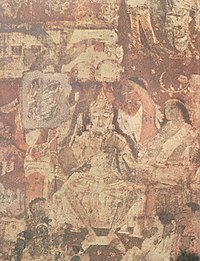King of Sri Lanka
| King of the Sinhala Kingdom | |
|---|---|

Royal Standard of the King of Kandy in 1815
|
|

Vijaya, the first Sinhalese King
|
|
| Details | |
| First monarch | Vijaya |
| Last monarch | Sri Vikrama Rajasinha |
| Formation | 543 BC |
| Abolition | 1815 AD |
| Residence | Tambapanni, Anuradhapura, Pulatthinagara,Polonnaruwa, Dambadeniya, Gampola, Kotte, Kandy |
The Sinhalese monarch was the head of state of the Sinhala Kingdom. Anachronistically referred to as the Kings of Sri Lanka, the monarch held absolute power and succession was hereditary. The monarchy comprised the reigning monarch, his or her family, and the royal household which supports and facilitates the monarch in the exercise of his royal duties and prerogatives.
The Sinhalese monarchy has its origins in the settlement of North Indian Indo-Aryan immigrants to the island of Sri Lanka. The Landing of Vijay as described in the traditional chronicles of the island, the Dipavamsa, Mahavamsa and Culavamsa, and later chronicles, recount the date of the establishment of the first Sinhala Kingdom in 543 BC when Prince Vijaya (543–505 BC), an Indian Prince, and 700 of his followers landed on the island of Sri Lanka and established the Kingdom of Tambapanni. In Sinhalese mythology, Prince Vijaya and followers are told to be the progenitors of the Sinhalese people. However according to the story in the Divyavadana, the immigrants were probably not led by a scion of a royal house in India, as told in the romantic legend, but rather may have been groups of adventurous and pioneering merchants exploring new lands.
The Sinhala Kingdom concerns the political states of the Sinhalese people and their ancestors; it existed not as one continuous state but has been historically referred to as a series of successive kingdoms known by the city at which its administrative centre was located. These are in chronological order: the kingdoms of Tambapanni, Upatissa Nuwara, Anuradhapura, Polonnaruwa, Dambadeniya, Gampola, Kotte, Sitawaka and Kandy. The kingdoms existed in what is today the modern state of Sri Lanka. The Sinhala Kingdom ceased to exist by 1815 with Sri Vikrama Rajasinha of Kandy after generations of European influences and upheaval in the royal court. During the two millennia in which the Kingdom existed, other political entities also existed on the island, including the Jaffna Kingdom,Vanni chieftaincies and the Portuguese and Dutch colonies. However, these political entities were not part of the Sinhala Kingdom.
...
Wikipedia
